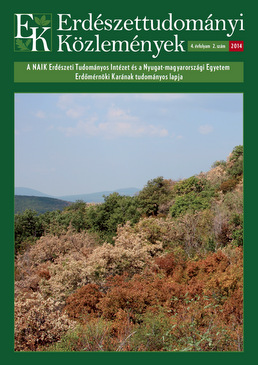| 1. | Blommberg, W.J. and Hall, A.A. 1986: Effects of laminated root rot on relationships between stem growth and root-systemsize, morphology, and a spatial distribution in Douglas-fir. Forestry Sciences, 32 (1): 202–219. |
| 2. | Büttner, V. and Leuschner, C. 1994: Spatial and temporal patterns of fine root abundance in a mixed oak-beech forest. Forest Ecology and Management, 70 (1–3): 11–21. DOI: 10.1016/0378-1127(94)90071-x |
| 3. | Faragó S. 1960: Homoki cserjék gyökérfeltárása. Erdészeti Kutatások, 56 (1–3): 341–360. |
| 4. | Faragó, S. 1972: Investigations on the growth rate of Austrian pine (Pinus nigra) roots and side branches. Erdészeti Kutatások, 68 (2): 155–176. |
| 5. | Führer E. és Jagodics A. 2009: A klímajelző fafajú állományok szénkészlete. „Klíma-21” Füzetek, 57: 43–55. |
| 6. | Führer E. 2010: A fák növekedése és a klíma. „Klíma-21” Füzetek, 61: 98–107. |
| 7. | Führer E.; Czupy Gy.; Kocsisné Antal J. és Jagodics A. 2011a: Gyökérvizsgálatok bükkös, gyertyános-kocsányos tölgyes és cseres faállományban. Agrokémia és Talajtan, 60 (1): 103–118. |
| 8. | Führer, E.; Horváth, L.; Jagodics, A.; Machon, A. and Szabados, I. 2011b: Application of a new aridity index in Hungarian forestry practice. Időjárás, 115 (3): 205–216. |
| 9. | Glatzel, G. 1983: Root distribution and soil water depletion in an Oak-Hornbeam stand (Quercus petraea, Q. robur, Carpinus betulus) and Spruce Thicket (Picea abies). In: Böhm, W.; Kutschera, L. und Lichtenegger, E. (eds): Wurzelökologie und ihre Nutzanwendung. Internationales Symposium vom 27-29. September 1982. Bundesanstalt für alpenländische Landwirtschaft, Gumpenstein, A-Irdning. 65–88. |
| 10. | Göttsche, D. 1972: Verteilung von Feinwurzeln und Mykorrhizen im Bodenprofil eines Buchen- und Fichtenbestandes im Solling. Mitteilungen der Bundesforschungsanstalt für Forst- und Holzwirtschaft, 88: 1–102. |
| 11. | Gyarmatiné Proszt S. 1978: A trágyázás. In: Keresztesi B. és Solymos R. (eds): A fenyők termesztése és a fenyőgazdálkodás. Akadémiai Kiadó, Budapest. |
| 12. | Hoffmann, G. 1974: Einfluss von Sommerdürre auf das Wurzelwachstum von Lärche (Larix leptolepis). In: Hoffmann, G. (ed): Ökologie und Physiologie des Wurzelwachstums. II. Internationales Symposium, Potsdam 1971. Berlin, Akademie Verlag. |
| 13. | Járó Z. és Horváth E-né 1959: Tápanyag-körforgalom a magyar erdő egyes típusaiban. Erdészeti Kutatások, 6(1–2): 231–246. |
| 14. | Járó Z. 1979: A kultúrerdők ökoszisztéma-vizsgálata. Monográfia. MTA Veszprémi Akadémiai Bizottság Kiadványai, 5 (1). |
| 15. | Járó Z. 1990: A bükkösök szerves- és tápanyagforgalma. Erdészeti Kutatások, 80–81: 83–98. |
| 16. | Járó Z. 1991: Lomberdők gyökérrendszere és gyökértömege. Erdészeti és Faipari Tudományos Közlemények, 1: 5–22. |
| 17. | Járó Z. 1995: A legfontosabb magyarországi természetszerű, származék és kultúr erdőtársulások évi szervesanyagképzése. 1385. számú OTKA pályázat. |
| 18. | Karpov, V.G. (ed) 1983: Regulation factors of spruce forest ecosystems. Nauka, Leningrad. 317 p. (in Russian) |
| 19. | Magyar P. 1929: Gyökérvizsgálatok csemetekerti és szikes talajban. Erdészeti Kísérletek, 31 (2): 117–165. |
| 20. | Magyar P. 1961: Gyökérvizsgálatok. In: Magyar P.: Alföldfásítás II. Akadémiai Kiadó, Budapest, 86–104. |
| 21. | Marjanović, H.; Alberti, G.; Balogh, J.; Czóbel, Sz.; Horváth, L.; Jagodics, A.; Nagy, Z.; Ostrogović, M.Z.; Peressotti, A. and Führer, E. 2011: Measurements and estimations of biosphere-atmospohere exchange of greenhouse gases – Forests. In: Haszpra, L. (ed): Atmospheric Greenhouse Gases: The Hungarian Perspective. Springer Science+Media B.V., Dordrecht – Heidelberg – London – New York. 121–156. |
| 22. | Persson, H. 1979: Fine-root production, mortality and decomposition in forest ecosystems. Vegetatio, 41(2): 101–109. DOI: 10.1007/bf00121422 |
| 23. | Persson, H. 1980: Spatial distribution of fine-root growth, mortality and decomposition in a young Scots pine stand in Central Sweden. Oikos, 34: 77–87. DOI: 10.2307/3544552 |
| 24. | Rastin, N. 1991: Influence of waterlogging on root distribution, fine-root biomass and mycorrhizal number of norway spruce. In: McMichael, B.L. and Persson, H. (eds): Plant roots and their environment. Amsterdam, Elsevier, 319–331. DOI: 10.1016/b978-0-444-89104-4.50046-3 |
| 25. | Santantonio, D., 1990: Modeling growth and production of tree roots. In: Dixon, R.K.; Meldahl, R.S.; Ruark, G.A. and Warren, W.G. (eds): Process modeling of forest growth responces to environmental stress. Portland, Timber Press, 124–141. |
| 26. | Ujváriné Jármay É.; Járó Z. és Ujvári F. 2001: A biomassza mennyisége, megoszlása és változatossága a nemzetközi lucfenyő származási kísérletben (IUFRO 1964/68). Erdészeti Kutatások, 90: 49–64. |
| 27. | Yin, X.; Perry, J.A.; Dixon, R.K. 1989: Fine-root dynamic and biomass distribution in a Quercus ecosystem following harvesting. Forest Ecology and Management, 27 (3–4): 159–177. DOI: 10.1016/0378-1127(89)90105-9 |
